Book contents
- Frontmatter
- Contents
- List of Illustrations
- Acknowledgements
- List of Contributors
- Abbreviations
- 1 Place-Names, Language and the Anglo-Saxon Landscape: An Introduction
- 2 The Landscape of Place-Name Studies
- 3 Place-Names as Travellers' Landmarks
- 4 Light thrown by Scandinavian Place-Names on the Anglo-Saxon Landscape
- 5 Language and the Anglo-Saxon Landscape: Towards an Archaeological Interpretation of Place-Names in Wiltshire
- 6 Hunting the Vikings in South Cumbria from Ambleside to Haverbrack
- 7 Viking-Age Amounderness: A Reconsideration
- 8 The Woodland Landscape of Early Medieval England
- 9 The Pre-Conquest Lands and Parish of Crediton Minster, Devon
- 10 Rewriting the Bounds: Pershore's Powick and Leigh
- 11 That ‘Dreary Old Question’: The Hide in Early Anglo-Saxon England
- 12 Boroughs and Socio-Political Reconstruction in Late Anglo-Saxon England
- Index
2 - The Landscape of Place-Name Studies
Published online by Cambridge University Press: 05 February 2013
- Frontmatter
- Contents
- List of Illustrations
- Acknowledgements
- List of Contributors
- Abbreviations
- 1 Place-Names, Language and the Anglo-Saxon Landscape: An Introduction
- 2 The Landscape of Place-Name Studies
- 3 Place-Names as Travellers' Landmarks
- 4 Light thrown by Scandinavian Place-Names on the Anglo-Saxon Landscape
- 5 Language and the Anglo-Saxon Landscape: Towards an Archaeological Interpretation of Place-Names in Wiltshire
- 6 Hunting the Vikings in South Cumbria from Ambleside to Haverbrack
- 7 Viking-Age Amounderness: A Reconsideration
- 8 The Woodland Landscape of Early Medieval England
- 9 The Pre-Conquest Lands and Parish of Crediton Minster, Devon
- 10 Rewriting the Bounds: Pershore's Powick and Leigh
- 11 That ‘Dreary Old Question’: The Hide in Early Anglo-Saxon England
- 12 Boroughs and Socio-Political Reconstruction in Late Anglo-Saxon England
- Index
Summary
Landscape Studies and Place-Names
Those concerned with the study and interpretation of place-names in England have for a long time recognised the importance of locating the names within their topographical context. They have also advocated the use of place-names as clues to lost features of the landscape. Thus, already in 1924 in the Introduction to the Survey of English Place-Names, W. J. Sedgefield observed:
in many cases a knowledge of local configuration will be of great help. It may enable us to decide, for example, between confused suffixes. Thus when early forms leave us in doubt whether the original suffix was -hale or -hill, a knowledge of the actual local conditions may resolve our hesitation at once … place-names sometimes record a church or other building which has long ceased to exist. In other cases evidence of a different condition of the surface of the country-side is furnished; for example, of a forest which is now agricultural land or of a fen or moor which no longer exists.
However, despite Sedgefield's positive statement, and although it appears self-evident to most medievalists today, the general relevance of place-names to studies of historical topography has only comparatively recently been acknowledged by those outside onomastics. It is particularly noteworthy that W. G. Hoskins' pioneering book The Making of the English Landscape did not include ‘place-names’ as a category in its index and that in 1955 he could state:
the Old English have left us with almost no word at all about the kind of landscape they found on arrival, that they set out to reclaim from the natural wilderness. They had no eye for scenery, any more than other hard-working farmers of later centuries.
- Type
- Chapter
- Information
- Place-names, Language and the Anglo-Saxon Landscape , pp. 23 - 50Publisher: Boydell & BrewerPrint publication year: 2011

